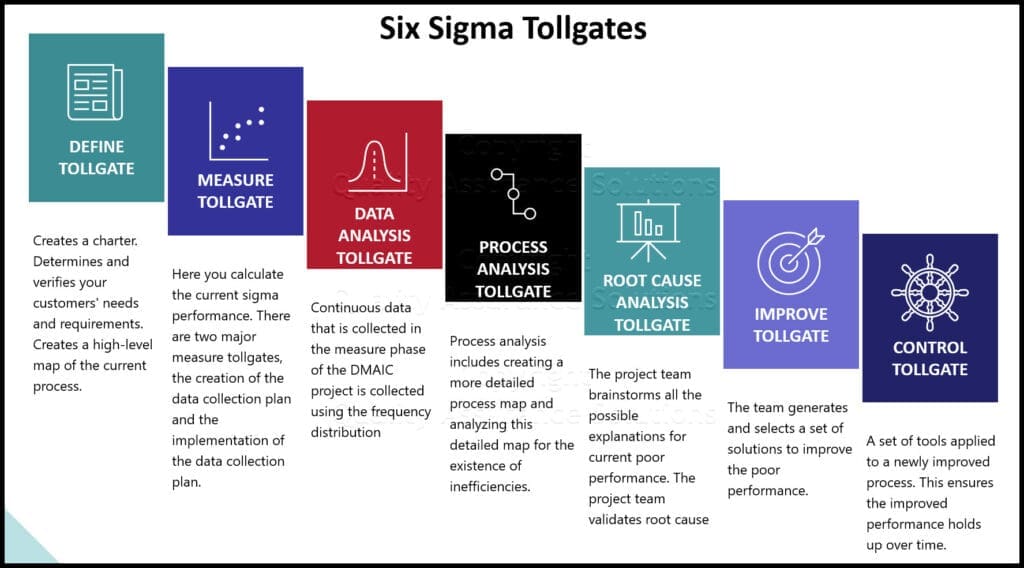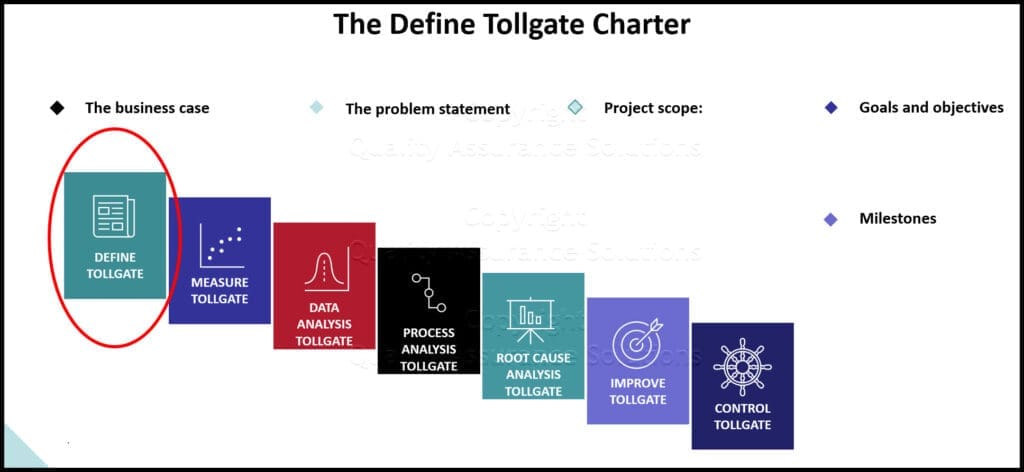Table of contents
Estimated reading time: 10 minutes
Six Sigma “Define” Tollgate Definition
What is a tollgate review Six Sigma? The Lean Six Sigma tollgate definition is a structured checkpoint or milestone within a project that aims to evaluate progress, validate deliverables, and ensure that the project is meeting predefined criteria before proceeding to the next phase. It’s a critical part of the Lean Six Sigma methodology, which combines principles from Lean (focused on reducing waste) and Six Sigma (aimed at minimizing defects and variations).
Tollgate reviews typically occur after each phase of a project and involve stakeholders, team members, and project leaders. These reviews assess whether the project has achieved its objectives and if it’s ready to move forward to the next phase. They ensure that decisions are data-driven and that necessary improvements are incorporated to enhance project outcomes.
Key Elements of a Six Sigma Tollgate Review
- Evaluation of Deliverables: Assessing the completion and quality of the deliverables produced in the current phase.
- Review of Metrics and Data: Analyzing relevant metrics and data to ensure they meet the predefined targets and objectives.
- Stakeholder Alignment: Ensuring that stakeholders are aligned with the project’s progress, goals, and outcomes.
- Risk Assessment: Identifying any potential risks or issues that might affect the project’s success and devising mitigation strategies.
- Decision-Making: Deciding whether the project should proceed to the next phase, be adjusted, or be halted based on the review’s findings.
- Documentation: Proper documentation of the review findings, decisions made, and actions required for the subsequent phase.
These checkpoints or tollgates, as part of the Six Sigma tollgate definition, are critical in maintaining project discipline, ensuring alignment with organizational goals, and minimizing risks throughout the project lifecycle in the Six Sigma process.
By conducting tollgate reviews, organizations implementing Lean Six Sigma can maintain control over project progress, validate improvements, and ensure that projects stay aligned with organizational goals. These reviews also facilitate continuous improvement by allowing teams to learn from each phase and make necessary adjustments for better results in subsequent stages.

“Define” the Tollgate Review in Six Sigma
The Six Sigma tollgate definition is a structured checkpoint or milestone that serves as an evaluation point during different stages of a project. It acts as a gatekeeper before progressing from one phase to the next. These reviews ensure that the project is meeting predefined objectives, adhering to established timelines, and maintaining quality standards. Tollgate reviews are crucial for assessing project readiness and determining whether to proceed, pause, modify, or terminate the project.
Key aspects of a tollgate review include:
- Evaluation Criteria: Clear criteria and metrics are established at the beginning of the project for each phase. These criteria define what success looks like at each checkpoint, helping in the assessment of project progress.
- Documentation and Reporting: The team compiles relevant data, reports, and documentation to present the project status, achievements, challenges, and plans. This information helps stakeholders understand the project’s current state and what to expect in the upcoming phase.
- Decision Making: Stakeholders, project sponsors, and relevant personnel convene to review the project’s status and determine whether it meets the criteria for advancing to the next phase. Decisions might involve approving the continuation of the project, requesting modifications, or deciding to terminate it.
- Risk Assessment: Tollgate reviews often involve a risk assessment to identify potential risks or issues that could impact project success. Addressing these concerns helps in mitigating risks or making informed decisions about project modifications.
- Quality Control: Ensuring that the project aligns with quality standards and meets customer requirements is paramount. The tollgate review evaluates whether the project output aligns with these quality parameters.
- Learning and Improvement: Lessons learned from the current phase are often discussed during tollgate reviews. This includes identifying what worked well, what didn’t, and how processes can be improved in subsequent phases.

Purpose and Objectives of the “Define” Tollgate Review
In the Define phase of Six Sigma, the primary objectives involve setting the project’s foundation, understanding customer requirements, defining project scope, identifying stakeholders, and outlining an initial project plan. The Tollgate Review, which is a pivotal part of the Six Sigma methodology and plays a crucial role in understanding what is tollgate in Lean Six Sigma, aligns seamlessly with these objectives. It serves as a critical measure to verify if the Define phase goals, including what is a tollgate review Six Sigma, have been adequately addressed. Its significance lies in its ability to validate the project’s direction and ensure alignment with both customer needs and business objectives.
Components Evaluated in the “Define” Tollgate Review
Project Charter: The Project Charter serves as the project’s North Star, outlining its purpose, scope, objectives, and constraints. It acts as a guiding document aligning the project with organizational goals and strategies.
Voice of the Customer (VOC): Gathering and understanding customer requirements and expectations is fundamental. The VOC analysis ensures that the project remains customer-centric, meeting their needs and enhancing satisfaction.
Project Scope: Defining clear boundaries, objectives, and constraints ensures a focused approach, preventing scope creep and ensuring project alignment with predefined goals.
Stakeholder Analysis: Identifying and comprehending stakeholders’ needs, expectations, and influence levels are crucial for effective project management and engagement.
Initial Project Plan: An overview of the plan to achieve project objectives, including timelines, resource allocation, and key milestones.
Executing a Successful “Define” Tollgate Review
Executing a successful Define Tollgate Review in the context of Six Sigma involves careful planning, preparation, and adherence to specific steps to ensure that the project is set up for success right from the start. The Define phase is the first phase in the DMAIC (Define, Measure, Analyze, Improve, Control) framework of Six Sigma, and the tollgate review at this stage is critical in laying the foundation for the project’s success. Here’s a step-by-step guide to executing a successful define Tollgate Review:
- Establish Clear Objectives: Clearly define the project objectives, scope, and goals. Ensure that these are aligned with the organization’s overall strategic goals.
- Assemble the Project Team: Form a cross-functional team comprising individuals with diverse skills and expertise relevant to the project, including a thorough understanding of Six Sigma tollgate principles. Ensure that team members understand their roles, responsibilities, and contributions.
- Create a Project Charter: Develop a project charter that outlines the project’s purpose, scope, objectives, stakeholders, expected outcomes, and initial timeline. This document serves as a roadmap for the project, including considerations for Six Sigma tollgate checkpoints.
- Define Metrics and Success Criteria: Establish key metrics and success criteria that will be used to measure the achievement of objectives, integrating elements pertinent to Six Sigma tollgate methodologies. These metrics should be specific, measurable, achievable, relevant, and time-bound (SMART).
- Perform Stakeholder Analysis: Identify and analyze stakeholders who will be impacted by or have an influence on the project, incorporating perspectives crucial for Six Sigma tollgate assessments. Understand their needs, expectations, and levels of involvement.
- Gather Voice of the Customer (VOC): Collect and analyze customer requirements, preferences, and expectations, aligning findings with the Six Sigma Tollgate principles. This helps in ensuring that the project aligns with customer needs as well as the tollgate review criteria.
- Develop Process Maps and High-Level Scope: Create process maps or flowcharts to understand the current process and identify areas for improvement, aligning with Six Sigma tollgate checkpoints. Determine the high-level scope of the project while considering tollgate review milestones.
- Risk Assessment and Mitigation Plan: Identify potential risks and uncertainties that could affect the project’s success, accounting for Six Sigma tollgate assessments. Develop a risk mitigation plan to address these risks proactively, in line with tollgate review requirements.
- Prepare for the Tollgate Review: Compile all the necessary documentation, including the project charter, stakeholder analysis, VOC data, process maps, risk assessment, and any other relevant information essential for Six Sigma Tollgate evaluations.
- Conduct the Tollgate Review Meeting: Schedule a meeting with key stakeholders, sponsors, and relevant team members to present the findings, progress, and plans from the Define phase, aligning with Six Sigma Tollgate protocols and the Six Sigma Tollgate definition. Present the project charter, objectives, scope, metrics, stakeholder analysis, VOC findings, process maps, and risk mitigation plan. Facilitate discussions to seek feedback, address concerns, and obtain approval to proceed to the Measure phase, adhering to tollgate review guidelines.
- Document Feedback and Next Steps: Document the feedback received during the tollgate review meeting in accordance with Six Sigma tollgate standards. Capture any action items, modifications, or additional requirements for the next phase. Obtain formal approval or authorization to move forward to the Measure phase while considering tollgate criteria.
- Closure and Communication: Communicate the outcomes of the tollgate review to all stakeholders, ensuring clarity on decisions made, any changes, and the next steps in the project while adhering to Six Sigma tollgate principles.
By following these steps and ensuring thorough preparation and documentation, the Define Tollgate Review can be effectively executed, setting the stage for a successful Six Sigma project. Regular reviews and adherence to the DMAIC methodology throughout the project lifecycle will help maintain momentum and ensure continuous improvement.

Benefits and Importance of an Effective Tollgate Review
Clear Project Direction
Alignment with business goals ensures the project remains on track, focusing efforts on what truly matters.
Stakeholder Engagement
Involving stakeholders enhances buy-in and ensures that their needs are met, fostering a collaborative environment.
Risk Reduction
Early identification of potential risks allows for timely mitigation strategies, minimizing adverse impacts on project outcomes.
Clarity on Scope and Objectives
Avoiding ambiguity ensures everyone involved understands the project’s boundaries and goals.
Six Sigma “Define” Tollgate Review and Deliverables
Has the Project Team been developed?
- Are the team and project sponsored by a champion or business leader?
- Is the team comprised of SMEs
- Have they had the Yellow Belt Training?
Has the “Project Charter” been developed?
(The following questions should help determine the answer)
- Business Case: What are the compelling business reasons for embarking on this project?
- Is the project linked to key business goals and objectives?
- What key business process output measure(s) will the project leverage and how?
- What are the rough order estimates on cost savings/opportunities on this project
Problem Statement (Starting Line):
- What specifically is the problem?
- Do we understand the Customers’ Requirements?
- Have the customer’s been identified?
- Has the improvement team collected the ‘voice of the customer’ (obtained feedback – qualitative and quantitative)?
- What customer feedback methods were used to solicit their input?
- Have the customer needs been translated into specific, measurable requirements?
Has a SIPOC diagram been produced describing the Suppliers, Inputs, Processes, Outputs, and Customers?
Have you used a Lean tool like the Value Stream Map to Identify Waste in the Process and to help in the Project Scoping process?
Define Stage Deliverables:
- The Project Team has been developed and is sponsored by a champion or business leader.
- Project management charter, including business case, problem and goal statements, project scope, milestones, roles and responsibilities, and communication plan.
- Completed SIPOC representation, describing the Suppliers, Inputs, Processes, Outputs, and Customers.
- Completed Value Stream Map to show the “present state” of Waste in the process and to further scope (If applicable)
- Red flags and recommendations for resolution defined
- Next steps documented
- Approval of report out signed by Project Champion
Conclusion and Next Steps
In summary, if you’re still wondering what is tollgate review in lean Six Sigma projects? In the Six Sigma tollgate definition, you will find that acts as a crucial evaluation point, ensuring projects are on track, aligned with objectives, and primed for success. Encouraging readers to implement effective tollgate reviews in their projects, this checkpoint serves as a linchpin for quality-driven, successful project management.



